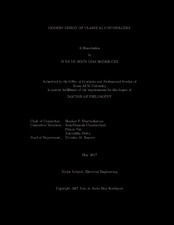| dc.description.abstract | Classical controller design emphasizes simple low-order controllers. These classical controllers include Proportional-Integral (PI), Proportional-Integral-Derivative (PID), and First Order. In modern control theory, it is customary to design high-order controllers based on models, even for simple plants. However, it was shown that such controllers are invariably fragile, and this led to a renewal of interest in classical design methods. In the present research, a modern approach to the design of classical controllers (by introducing a complete stabilizing set in the space of the design parameters) is described. When classical specifications such as gain margin, phase margin, bandwidth, and time-delay tolerance are imposed, the achievable performance can be easily determined graphically. The objective of this research is to determine the controller gains, contained in the stabilizing set, which satisfy desired performance specifications such as crossover frequency and closed-loop stability margins. The design procedure starts with the calculation of the stabilizing set using recent methods. Then, a simple parametrization produces ellipses and straight lines (for PI controller design) and cylinders and planes (for PID controller design) in the space of controller gains. Each set of ellipses/cylinders and straight lines/planes represents constant magnitude and constant phase loci for the controller. The main result is that the crossing points, which are the intersection of ellipses/cylinders and straight lines/planes, are selected such that they are contained in the stabilizing set of controllers. They provide the controller gains that we need to satisfy our desired robust performance, seen as desired gain margin, phase margin, gain crossover frequency, and time-delay tolerance in our system. Then, using these crossing points contained in the stabilizing set, a new plot with information about the achievable performance in terms of gain margin, phase margin, and gain crossover frequency is constructed. Each point of this achievable performance can be used to retrieve the controller’s gains, which are contained in the stabilizing set. This result provides the possibility to analyze the system’s achievable performance by exploring the stabilizing set and considering different desired configurations in the performance capabilities for the system using a PI or PID controller. This expands our possibilities when designing controllers by considering different classical controller’s configurations. This research considers the discrete-time and continuous-time linear time invariant systems and cases including First Order with time-delay in the system, and the extension to the controller design for multivariable systems. Finally, the design procedure is illustrated with different examples and real applications for all such cases. | en |


